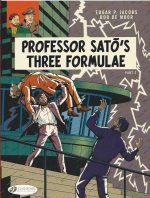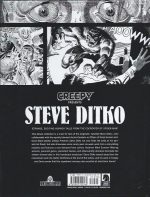
By Edgar P. Jacobs & Bob De Moor with colours by Paul-Serge Marssignac, translated by Jerome Saincantin (Cinebook)
ISBN: 978-1-84918-303-1
Belgian Edgard Félix Pierre Jacobs (March 30th 1904-February 20th 1987) is rightly considered one of the founding fathers of the Continental comics industry. Although his output was relatively modest compared to many of his iconic contemporaries, Jacobs’ landmark serialised epic starring scientific adventurers Professor Philip Mortimer and Captain Francis Blake practically formed the backbone of the modern action-adventure comic in Europe.
His splendidly adroit, roguish yet thoroughly British adventurers were conceived and realised for the very first issue of Le Journal de Tintin in 1946, and quickly became a crucial staple of life for post-war European kids – in exactly the same way Dan Dare was for 1950s Britain.
Jacobs was born in Brussels, a precocious child perpetually drawing, but even more obsessed with music and the performing arts – especially opera. He attended a commercial school but loathed the idea of office work, so instead avidly pursued arts and drama on his graduation in 1919.
A succession of odd jobs at opera-houses (scene-painting, set decoration and even performing as both an acting and singing extra) supplemented his private performance studies, and in 1929 Jacobs won an award from the Government for classical singing.
His dreamed-of operatic career was thwarted by the Great Depression. When arts funding suffered massive cutbacks following the global stock market crash, he was compelled to pick up whatever dramatic work was going, although this did include more singing and performing.
Jacobs switched to commercial illustration in 1940, winning regular work in the magazine Bravo, as well as illustrating short stories and novels. He famously took over the syndicated Flash Gordon strip after the occupying German authorities banned Alex Raymond’s quintessentially All-American Hero and the publishers desperately sought someone to satisfactorily complete the saga.
Jacobs’ ‘Stormer Gordon’ lasted less than a month before being similarly embargoed by the Occupation fun-police, after which the man of many talents simply created his own epic science-fantasy feature in the legendary Le Rayon U: a milestone in both Belgian comics and science fiction adventure.
During this period Jacobs and Tintin creator Hergé got together, and whilst creating the weekly U Ray strip, the younger man began assisting on Tintin, colouring the original black and white strips of The Shooting Star (originally run in newspaper Le Soir) for an upcoming album collection.
By 1944 Jacobs was performing similar duties on Tintin in the Congo, Tintin in America, King Ottokar’s Sceptre and The Blue Lotus. He was also contributing to the drawing too, working on the extended epic The Seven Crystal Balls/Prisoners of the Sun.
After the war and liberation, publisher Raymond Leblanc convinced Hergé, Jacobs and a few other comicstrip stars to work for his proposed new venture. Founding publishing house Le Lombard, Leblanc also commissioned Le Journal de Tintin, an anthology comic with simultaneous editions in Belgium, France and Holland to be edited by Hergé and starring the intrepid boy reporter supplemented by a host of newer heroes.
Beside Hergé, Jacobs and writer Jacques van Melkebeke, Le Journal de Tintin featured Paul Cuvelier’s ‘Corentin’ and Jacques Laudy’s ‘The Legend of the Four Aymon Brothers’.
As revealed in an enticing, photo-packed essay closing this Cinebook volume, Blake and Mortimer were a lucky compromise. Jacobs had wanted to create a period historical drama entitled Roland the Bold but changed genres due to an overabundance of such strips…
Laudy had been a friend of Jacobs’ since their time together on Bravo, and the first instalment of the epic thriller serial ‘Le secret de l’Espadon’ starred a bluff, gruff British scientist and an English Military Intelligence officer closely modelled on Laudy himself…
The initial storyline ran from issue #1 (26th September 1946) to September 8th 1949) and cemented Jacobs’ status as a star in his own right.
In 1950, with the first 18 pages slightly redrawn, The Secret of the Swordfish became Le Lombard’s first album release, with the concluding part published three years later. The volumes were reprinted nine more times between 1955 and 1982, in addition to a single omnibus edition released in 1964.
Hergé and Jacobs purportedly suffered a split in 1947 when the former refused to grant the latter a by-line on new Tintin material they had collaborated on, but since the two remained friends for life and Jacobs continued to produce Blake and Mortimer for the weekly comic, I think it’s fair to assume that if such was the case it was a pretty minor spat. I rather suspect that the Eccentric Englishmen were simply taking up more and more of the diligent artist’s time and attention…
In 1984 The Secret of the Swordfish was reformatted and repackaged for English translation as three volumes with additional material (mostly covers from the weekly Tintin added to the story as splash pages): part of a push to win some of the lucrative Tintin and Asterix market here. Sadly the tall tomes failed to find an audience and ended after seven magnificent if under-appreciated volumes.
Now happily Cinebook have finally made the Gentleman Heroes a bankable proposition, releasing all 23 extant albums with the most recent – due to the quirks of publishing – being the original twelfth and the last one that Jacobs was involved with.
For further details please check out yesterday’s review, but suffice to say that the concluding instalment of Professor SatÅ’s Three Formulae was a long time coming …
Les 3 formules du professeur SatÅ – Mortimer contre Mortimer was a tragically extended affair and only credited Jacobs as writer and layout artist. The eleventh album had been serialised between September 1971 and May 1972 in Tintin after which the author simply abandoned his story due to failing health and other issues.
He died on February 20th 1987 and soon after veteran cartoonist Bob de Moor (Bart de Scheepsjongen, Monsieur Tric, Cori le Moussaillon, Balthazar, Barelli and so many others) was commissioned by his family and estate to complete his final tale from Jacob’s pencils and notes.
The concluding album was finally released in March 1990, leading to a republishing of all the earlier exploits and eventually new adventures from a variety of creative teams…
Rather than make you wait eighteen years for the conclusion, here’s E.P Jacobs’ final foray starring the beloved tour de force scientific investigators.
As described yesterday, boisterous boffin Mortimer was in Japan when urgently contacted by robotics pioneer and cyberneticist supreme Professor Akira SatÅ. That savant had accomplished miracles in the mass-production of highly specialised mechanoids and androids, but his discoveries – parsed down into three crucial processes and deposited in three separate banks – were being targeted by a ruthless gang led by Blake and Mortimer’s greatest enemy.
The villains had infiltrated Satős home and laboratory and tried to murder Mortimer numerous times before creating a robot duplicate of the British scientist, but had been unable to stop a summons for help going out to his Secret Service ally. Now, with Blake imminently expected, the gang had to radically move up their timetable…
Captain Blake is watched from the moment he disembarks at Haneda Airport and the hidden enemies are already in place at the hotel where he is staying. The MI5 chief has the suite next to Mortimer’s, and although his old comrade is missing, finds plenty of clues as to what has happened to him. The diligent search also uncovers the video surveillance gear infesting both rooms and sets his watchers running for the exits in panic…
A hasty pursuit only leads to his own capture but, with fortune ever favouring the brave, Blake turns the tables on his foes in a deadly clash in the hotel garages and sends them all fleeing for their lives.
By the time he has connected with Police Superintendent Hasumi and briefed Colonel Mitsu of the Japanese Public Security Intelligence Agency, the assailants have vanished, but Blake is building a picture of what is going on. To end the Englishman’s threat forever, a diabolical and desperate scheme is devised: creating a second Mortimer robot to assassinate Blake…
Turncoat assistant Kim is nervous. Although he’s happy to use Professor SatÅ‘s incredible inventions to detain Mortimer and his former employer, the traitor is not conversant enough with the production procedures to guarantee success. Nevertheless, soon a deadly doppelganger of the British Professor is despatched to kill Blake…
Meanwhile, the real Mortimer has not been idle. With Satős aid he has escaped the lab prison and rushes to intercept the android assassin, but is unaware that behind him, unqualified hands have meddled with the duplication processes and a legion of horrific misfit mechanoids are tumbling off the conveyor belts…
What follows is a succession of spectacular chases, frantic battles and a final shattering showdown between Blake, Mortimer and the man who has bedevilled their lives since the days of the Swordfish case – a fitting end to the epic adventures and, thanks to the graphic efforts of De Moor, a perfect, revitalising stepping stone for other creators to renew and continue the feature…
Rocket-paced, suspenseful and cathartically action-packed, this is an enthralling changing-of-the-guard building to an explosive conclusion and satisfying final flourish, resulting in another superbly stylish blockbuster to delight every adventure addict.
As well as the aforementioned historical overview – ‘Jacobs: 1946, the Swordfish, starting point of a masterful work’ – this Cinebook edition also includes excerpts from two other Blake & Mortimer albums plus a short biographical feature and publication chart of Jacobs’ and his successors’ efforts.
Original edition © Editions Blake & Mortimer/Studio Jacobs (Dargaud-Lombard s. a.) 1990 by E.P. Jacobs & Bob De Moor. All rights reserved. English translation © 2016 Cinebook Ltd.











